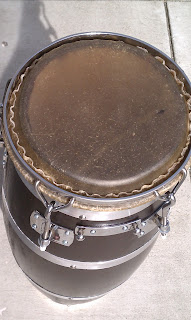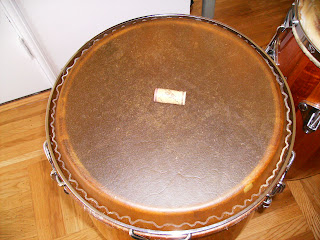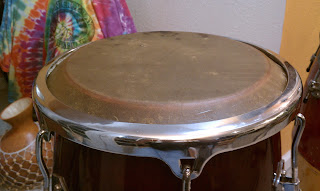
I have some of the nicest skins Ive seen, finished very clean. The tone and slaps I can get out of these skins, is really top notch. If you have played skins from Texas, for example, you will like these much better.
I supply skins to the top players in the business, like Sandy Perez, Perdrito Martinez, Roman Diaz and to professional percussionists across the country.
Getting the right skin depends of a few key factors:
1 - The material, make, and quality of the drum being skinned - often dictates what type of animal hide we will use.
2 - The style of music being played and the region where you are gigging - Timba with a big band, rumba, Latin jazz, rock and roll, drum circle hits.. region also matters.. East coast likes a bit more lively sound, for instance, dry southwest and humid south... Getting the thickness right for each situation is the key.

3 - The performance situation - outdoors/indoors, humidity issues, with or without amplification, playing acousticly with amplified musicians, etc... the need for projection, ease of playing for heavy gigging, long gigs or religious work, etc..
4 - The experience of the player - how solid the chops are of the player also factors into the thickness and type of skin, as comfort and ability to easily make the primary tones and slaps, and the need for projection must be considered in the selection.

Email me at congadr@gmail.com and we can talk about the right skin for you.
In response to a question about conga skins...
As far as Natural thickness from thin to thick,
--Calf (very young cow)
--Kip (young cow)
--Asian water buffalo
--Cow
--Steer/Bull
--Mule (offspring of male donkey and female horse)
That being said, there is a wide range in thickness of Mule, for example. and the supply of Mule is not plentiful. it is very difficult to get the right Mule skins and I have heard many a player complain about getting the wrong thickness, or having heavy flaws. If you get the right piece, Mule rocks for some specific uses.
Cow is much more available and the quality of product is much better. just much easier to find and thus easier to get a high quality piece.
Steer is not as varied in thickness as Cow. Kip and Calf are fairly uniform in thickness. Some Steer/Bull and some Mule is way too thick to use on a drum played with the hands. But some Steer is plained to a reasonable thickness for congas and sounds fine.
I think this discussion might be boiled down to this:
What skin is good for what drum?
What the pro's play in the bay area, in general
for salsa:
Oak quinto: medium to thick Mule, Steer or Cow
Oak conga: medium Cow
Oak Tumba: medium Cow
Mahogany quinto: medium Cow
Mahogany conga: medium Cow
Mahogany Tumba: medium Cow
Oak bongo: thin Mule or Horse, or kip on the Macho, med-thin Cow or medium Water Buff on the Hembra
Mahogany Bongo: thin Mule on the Macho, med-thin Cow, or medium water Buff on the Hembra
for Folkloric material - thicker in general:
Oak quinto: med-thick Mule Steer or Cow
Oak Conga: med-thick Mule or Cow
Oak Tumba: med-thick Cow
Mahogany quinto: medium Mule or Cow
Mahogany conga: medium Cow
Mahogany Tumba: medium Cow
Bata Cha's: med-thin Mule, or kip
Bata Iya's: medium Mule or Cow
Here is a post of a reskinning of a set of JCR Oak congas.. how to manage a ringy situation with the right skin - JCR Oak Conga Reskinning
I sell Cow, Calf and Kip. But i use Mule for my rumba quinto ax and for my Macho on my Mahogany bongo. - depends on the drum and the player, however.
Again, that being said. People with chops that need work, and are not regular or long time players need thinner skins than most to the working percussionist. If you have the chops, a thicker skin sounds much better as it kills any over ring. But too thick of a skin can be hard on the hands, even with good technique, and can kill the tone of a conga.
Hope that helps,
Tony










Hey Doctor Tony, can you give us a clinic on how to remove "skin suck"? Thanks, Chris Robarchek
ReplyDeleteHey Chris,
ReplyDeleteThe best way, of course, is not to get into that situation by preping the rim, and tightening as it dries - not too much.
But, if you have a skin that dries with a dip right inside the rim, if thats what you mean by skin suck, ive heard of a fix - but have not used it myself.
I was told to take the skin off, soak it upside down in shallow water, just about a half an inch in the water. Be careful not to soak the whole skin as the ring will come out.
After a few hours, prep the rim and put the half wet skin on the drum.
Be careful not to tighten it too much as it will tear at the point wet meets dry, only enough to stave off the dipping.
Let me know if it works, as ive never done it. I just replace the skin, if i see it.. it's just as easy.
Tony